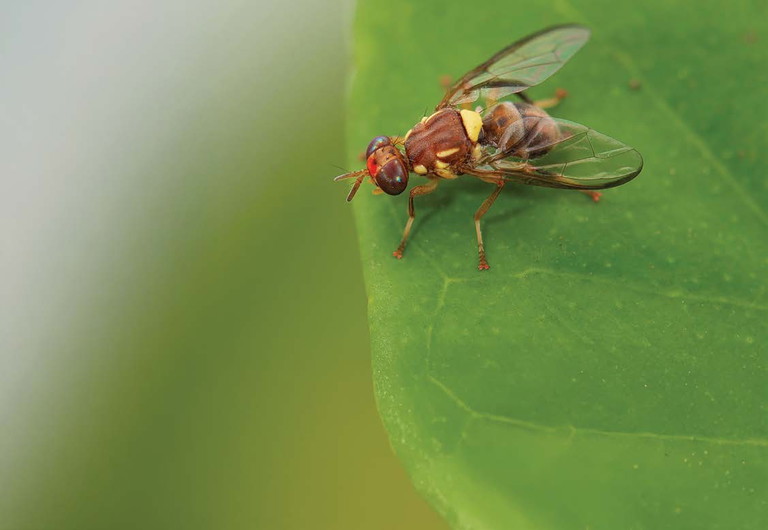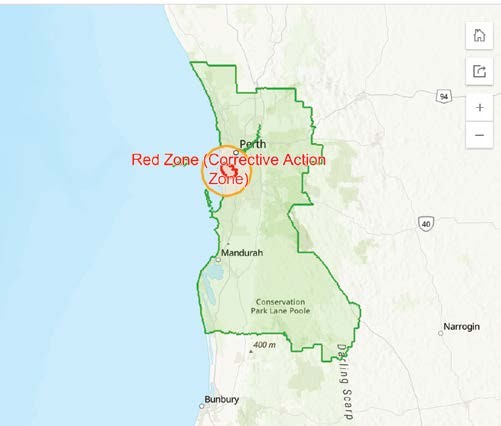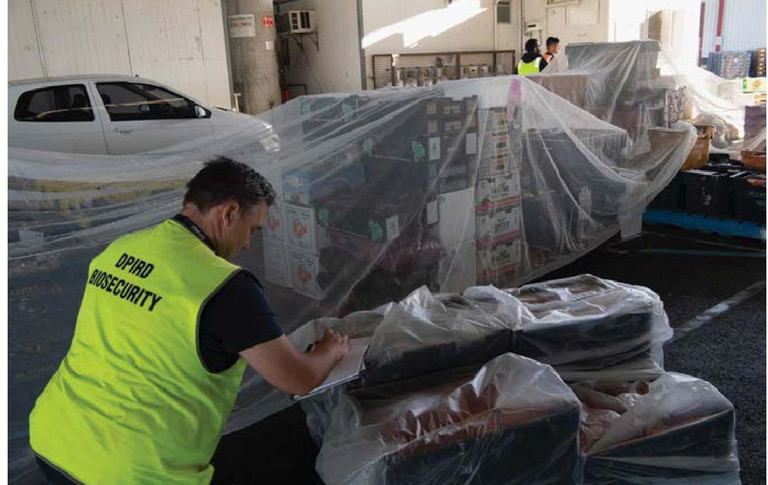UPFRONT qfly

DPIRD QFLY BIOSECURITY RESPONSE
working to protect horticulture production and market access
Queensland fruit fly (Bactrocera tryoni) is a serious pest, which attacks more than 300 species of fruit and fruiting vegetables, including tomatoes, capsicum and chillies.
A biosecurity response has ramped up to maintain Western Australia’s area freedom status for the invasive pest Queensland fruit fly (Qfly), led by the Department of Primary Industries and Regional Development (DPIRD).
THE response was initiated after a Qfly detection in the Perth southern suburb of Willagee in November 2024.
Qfly (Bactrocera tryoni) is a serious pest that attacks more than 300 species of fruit and fruiting vegetables, including tomatoes, capsicum and chillies.
Maintaining Area Freedom from Qfly allows WA growers to access valuable export markets, such as avocados to Thailand and Japan, and strawberries to Japan.
DPIRD has been providing regular Industry Updates, available on the department’s website.
The department’s response team of more than 200 is based at the new DPIRD State Biosecurity Response Centre in Canning Vale.
An extensive surveillance, baiting and treatment campaign covers more than 34,000 residences, in five local government areas.
As of mid-February, DPIRD field teams had undertaken more than 17,000 property visits and placed more than 5,000 lures in trees, alongside extensive baiting and trapping.
A Quarantine Area has been declared to support DPIRD’s efforts, requiring residents and businesses, with the assistance of local government, to take action to help protect gardens and stop the spread of the pest to the agricultural area.
The Quarantine Area includes two zones — a corrective action zone around where the pest was first found (Red Zone) and a buffer zone of surrounding suburbs within a 15 kilometre radius of the initial detections (Orange Zone).
DPIRD’s Qfly webpage features an online interactive map where residents can enter their address to find if their property is in the Red or Orange Zones (see Figure 1).
Residents and businesses in the Red Zone are required to strip fruit —regardless of maturity —to be consumed, cooked, frozen or solarised for at least a week, before disposing in the red general waste bin.
These efforts are complemented by an integrated communications campaign, including letters, media, social media, signage, fliers and community engagement.

FIGURE 1: DPIRD’s Quarantine Area interactive map Go to the DPIRD website www.wa.gov.au/qfly for the latest updates and to review the map

DPIRD is working with Canning Vale markets buyers and sellers to ensure produce is covered at all times, as well as farmers markets in the Quarantine Area.
Local government have been extremely supportive, undertaking works in parks and gardens, extending communications and providing some additional disposal options and facilities.
The biosecurity response is working with Perth Markets, which is in the Orange Zone, and its associated businesses to implement Quarantine Area measures that reduce the risk of spreading Qfly, such as covering produce.
The team has also been inspecting farmers markets to ensure host fruit and fruiting vegetables are securely covered with plastic wrap, tarpaulins, hessian, mesh or other coverings when entering and remaining in the Red Zone.
DPIRD Chief Plant Biosecurity Officer Vincent Lanoiselet said the department had the skills and experience to eradicate Qfly, having done so nine times in the past 40 years.
“The department’s Qfly surveillance program has once again proven to be an effective means of early detection and given us the best chance of eradication,” Dr Lanoiselet said.
“This campaign has hit the ground running and this large team is working hard alongside local government and the community to eradicate this pest and preserve WA’s enviable area freedom status.
“DPIRD is particularly grateful for the action of residents in the Red Zone, who are stripping their fruit trees and vegetable gardens to help stop the spread of this pest, which threatens home gardens, farmers’ crops and livelihoods, the environment and crucial market access.
“Together with the response efforts and the support of local government and the community, we will be able to complete this eradication program as quickly as possible.”
MORE INFORMATION
Reports of suspected Qfly can be made to DPIRD’s Pest and Disease Information Service on 9368 3080, email padis@dpird.wa.gov.au or via the MyPestGuide Reporter app.
More information on Qfly and the biosecurity response, including the interactive map, can be found on the department’s website www.wa.gov.au/qfly as the response progresses.